Brightspace Learning Environment
Activity Feed – Date picker change | New
This feature updates the date picker component in Activity Feed. The new date picker has a more streamlined design and requires slight workflow changes: to clear a date/time, use the Clear option and to set the calendar to the current day, use the Set to Today option.
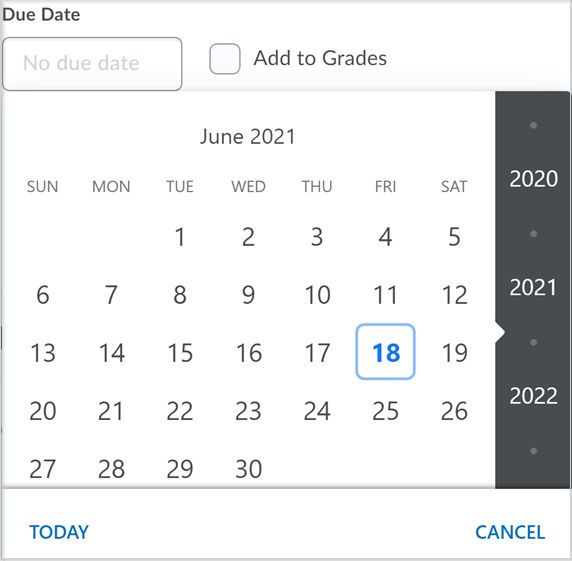
Figure: The date picker component in Activity Feed prior to the update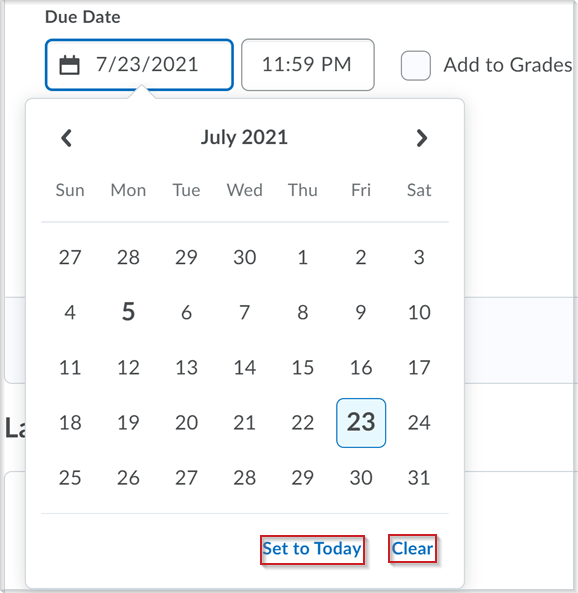
Figure: Updated date picker component in Activity Feed for due dates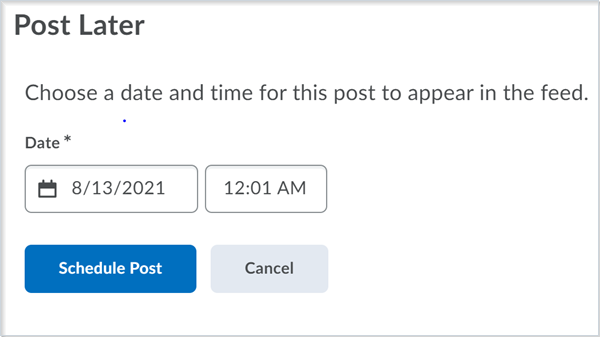
Figure: The Post Later dialog box in Activity Feed
Note: The Date field in the Post Later dialog box is a mandatory field. There remains to be no option to clear this field.
You must set this date to a future date or click Cancel to exit this dialog box.
| Impact of Change | Technical Details |
|---|---|
| Slight impact to instructors due to the updated date picker. | Availability: This feature is available to all clients To enable: This functionality is automatically turned on for all Activity Feed users. |
Assignments - Consistent evaluation experience | Updated
This feature is a continuation of the Assignments - Consistent evaluation experience feature introduced in December 2020/20.20.12, becoming the default Assignments experience in May 2021/20.21.5.
With this release, the new d2l.tools.Activities.CEAssignmentsOptIn configuration variable is now permanently turned on by default and hidden from administrators,
and the legacy assignment evaluation experience is retired.
For additional information on the consistent evaluation experience, visit the What is Coming in Evaluation: 20.20.12 post on Brightspace Community.
| Impact of Change | Technical Details |
|---|---|
| Slight impact to administrators due to an existing configuration variable that is now permanently turned on by default and hidden. | Availability: This feature is available to all clients. To enable: This feature is automatically enabled for Assignments users. |
| Large impact to instructors due to a new evaluation experience appearing by default in Assignments. | N/A |
Assignments - Icons in attachments toolbar | Updated
This release updates the attachments toolbar which appears in the evaluation panel
on the right side of the new Assignment Evaluation Experience.
Users can now add attachments to their feedback from QuickLinks, web links, Google
Drive, and OneDrive using the new icons in the toolbar. Previously, users could only
add attachments by uploading a file from their computer, recording an audio note,
or recording a video note.
This change aligns the attachments toolbar in the new Assignment Evaluation Experience
with the attachments toolbar in the new Create and Edit Assignment Experience.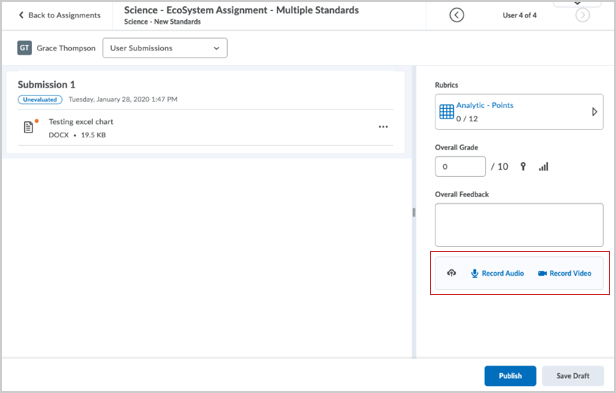
Figure: Previous attachments toolbar containing icons for Upload File, Record Audio,
and Record Video.
Figure: New attachments toolbar containing icons for Upload File, QuickLink, Web Link,
Google Drive, OneDrive, Record Audio, and Record Video.
| Impact of Change | Technical Details |
|---|---|
| Slight impact to administrators due to the ability to enable Google Drive Picker and OneDrive Picker. | Availability: This feature is available to all clients. To enable: Ensure the d2l.3rdParty.GoogleDrive.EnableGooglePicker configuration variable is enabled for the Google Drive icon to appear, and the d2l.3rdParty.OneDrive.EnableOneDrivePicker configuration variable is enabled for the OneDrive icon to appear. |
| Slight impact to instructors due to the ability to add feedback attachments from new sources. | N/A |
Assignments - Release Conditions sync with Grades | New
Assignment release conditions can now be automatically shared with associated grade
items in the new assignment creation experience. This ensures that both items follow
the same set of rules and become visible/accessible to learners at the same time.
This removes the need for instructors to manually recreate the release conditions
in two locations and makes all aspects of the assessment experience consistent for
the learner. Administrators can determine the behavior of assignment release conditions
with the new d2l.Tools.Grades.ReleaseConditionSync configuration variable. This is an organization level configuration variable; it can’t
be set on a course or department level. If the variable is turned on, it is on for
all courses.
Only changes made to the release conditions associated to the assignment are transferred
to grade items. If changes are made to the release conditions associated to the grade
item, those changes are not sent to Assignments. Once an assignment and grade item
have their release conditions linked, there is an information message on the Restrictions tab of the grade item, which informs you that release conditions are managed by the
associated assignment, with a link to the relevant assignment.
This feature only affects new assignments and edited assignments after the configuration
variable is turned on. Existing assignments are not retroactively updated. To update
existing assignments, instructors can edit and save individual assignments.
Refer to the Grade Release Conditions Are Removed When The Grade Is Associated To An Assignment article for more information.
| Impact of Change | Technical Details |
|---|---|
| Slight impact to administrators due to the need to update the new configuration variable if they want assignment release conditions to automatically sync with associated grade items. | Availability: This feature is available to all clients To enable: Set the new d2l.Tools.Grades.ReleaseConditionSync configuration variable to On. For more information, refer to the Partner Support page. |
| Moderate impact to instructors due to no longer needing to create identical release conditions in multiple locations to ensure a consistent assessment experience. | N/A |
Brightspace Editor – Available as the default editor | Updated
This feature updates the Brightspace Editor – Available in ePortfolio External Comments and Quiz Builder |
Updated feature released in July 2021/20.21.7.
This release sets the new Brightspace Editor as the default editor across Brightspace
Learning Environment. Administrators can no longer edit the d2l.Tools.WYSIWYG.NewEditor (Org) configuration variable, which will be archived in the September 2021/20.21.9 release.
As mentioned in the Brightspace Editor – Replaces The HTML Editor | New release note in April 2021, the Brightspace Editor does not have a built in spell
checker. Your web browser’s built-in spell check functionality is available in the
new Brightspace Editor and D2L recommends using it. However, the d2l.Tools.Quizzing.ShowSpellCheckInAttempts org unit configuration variable is still respected and marks text in Quizzes to be
ignored by the browser spell checker. It can be turned off for all quizzes at the
org unit level.
The inline limited version of Brightspace Editor is now available in Activity Feed
as the default editor.

Figure: The editor in Activity Feed before the update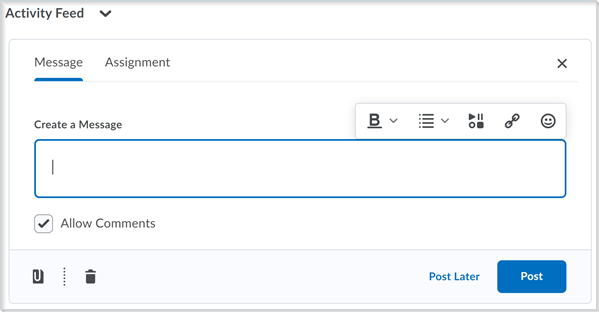
Figure: The updated inline limited version of Brightspace Editor in Activity Feed
Brightspace Editor HTML options in Activity Feed include: Bold, Italic, Underline,
Strike-through, Superscript, Subscript, Font Color, Bulleted Lists, Numbered Lists,
Increase/Decrease Indentation, Insert Stuff, Insert Quicklink, and Emoji. Insert Stuff
now includes various capabilities, including Video Note functionality.
The Account Settings > HTML Editor Settings option is no longer available as it is not applicable with the new Brightspace Editor.
This setting was previously used to make the HTML Editor more accessible to screen
readers by removing the RichText presentation layer. Improved accessibility workflows
in the new Brightspace Editor make this setting redundant.
Additionally, the Brightspace Editor now remembers the open or closed state of the More Actions button, per user, in order to reduce clicks for users that frequently use options
in the expanded editor.
The Brightspace Editor now uses pixels (px) in the font size menu in order to match the Content Settings menu for an org unit’s default font size.
| Impact of Change | Technical Details |
|---|---|
| Moderate impact to users due to the new Brightspace Editor being the default editor across Brightspace Learning Environment. | Availability: This feature is available to all clients To enable: This feature is automatically turned on for all users. |
Brightspace Learning Environment – Supported Browsers | Updated
As an update to Brightspace Learning Environment – Supported browsers | Updated released in January 2021/20.21.1 and Brightspace Platform – Support alert banner for older browsers | New released in March 2021/20.21.3, the warning banner for legacy Edge has been removed on Aug 1st and replaced with a “your browser is unsupported” page with a Your browser is looking a little retro… pop-up message.
D2L recommends using Brightspace Learning Environment with an up-to-date browser that
provides robust support for all features. If you are using Brightspace Learning Environment
with a legacy browser, a pop-up message appears directing you to update your browser,
change to a supported browser, or dismiss the message.
Currently, the browser version check displays a warning for versions previous to:
- Chrome 90
- Chrome OS Chrome 90
- Mobile Chrome 90
- Safari 14
- Mobile Safari 14
- Firefox 88
- Chromium-based Microsoft Edge 90

Figure: The Your browser is looking a little retro… pop-up message.
The following message appears if you are using one of the following browsers (or older):
- Chrome 67 (released March 2018)
- macOS Safari 12 (released September 2018)
- Firefox 67 (released May 2019)
- Chrome OS Chrome 67 (released Mar 2018)
- iOS Safari 11 (released September 2017)
- Android Chrome 67 (released Mar 2018)
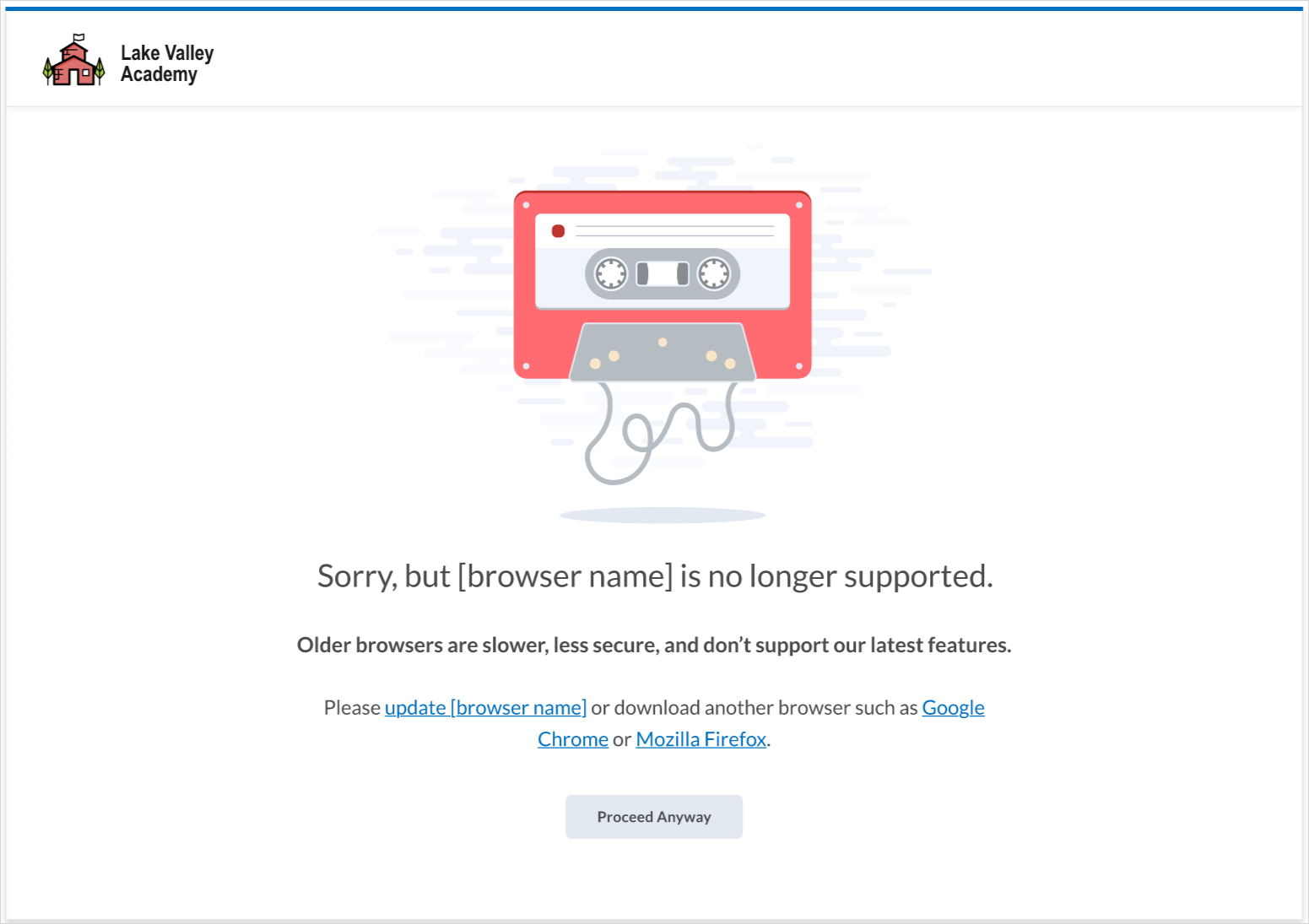
Figure: Legacy support tier/really prominent warning.
If you are using Legacy Edge (older than version 79) or Microsoft Internet Explorer
11, the following message appears:
Legacy Edge (Microsoft Edge versions <79) is now blocked from accessing Brightspace.
Cannot proceed at all. 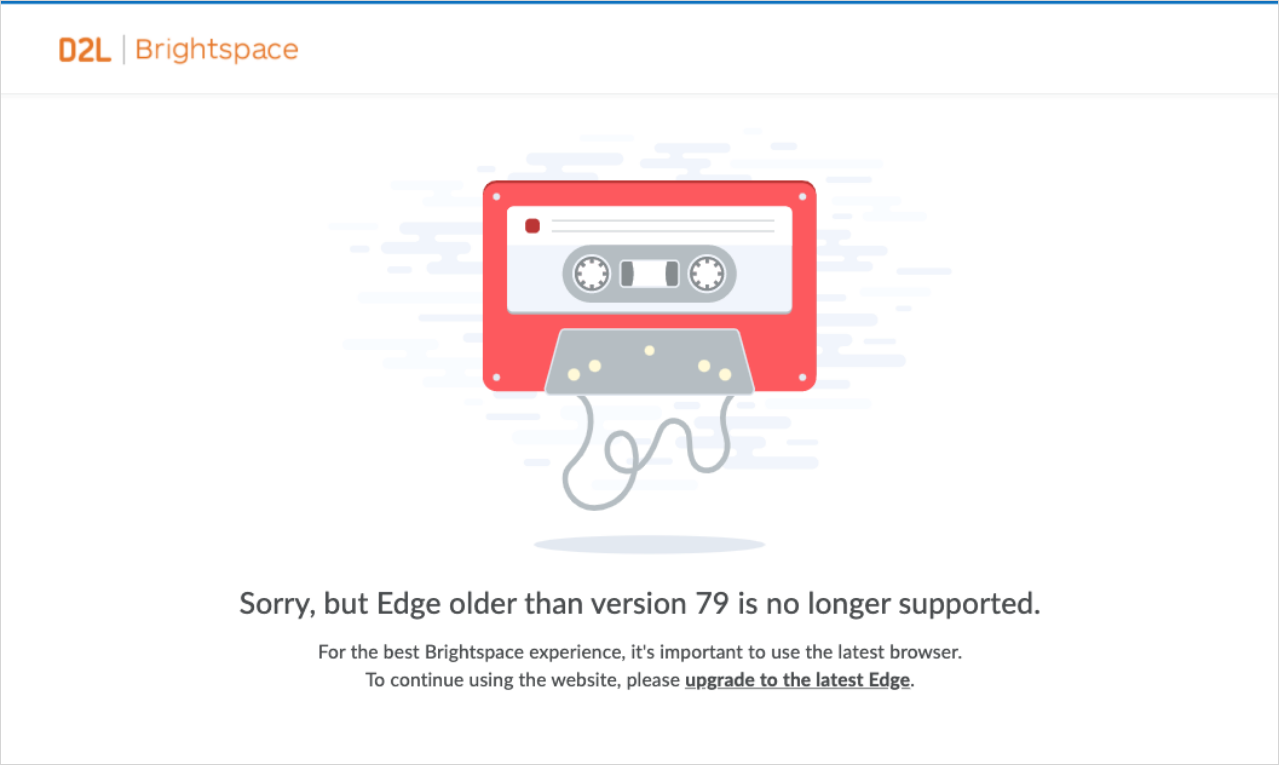
Figure: Blocked support tier warning.
| Impact of Change | Technical Details |
|---|---|
| Moderate impact to clients using legacy browsers. | Availability: This feature is available to all clients. To enable: This functionality is automatically enabled for Brightspace Learning Environment users. No further action is required. |
Brightspace Learning Environment – End of Life for Secondary Window Pop-Ups | New
This update brings End of Life status to the Show dialogs as pop-ups setting under Username > Account Settings. All secondary windows now open in Dialogs. Historically, this setting was used as
an Accessibility accommodation as not all Screen Readers were able to handle dialogs.
Modern screen readers provide better support for dialogs. The associated configuration
variable d2l.Preferences.NonModalDialogs(User) is also removed.
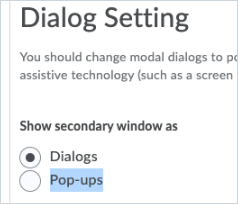
Figure: The Show secondary window as setting which has been removed.

Figure: Example of a secondary window opening in a pop up. 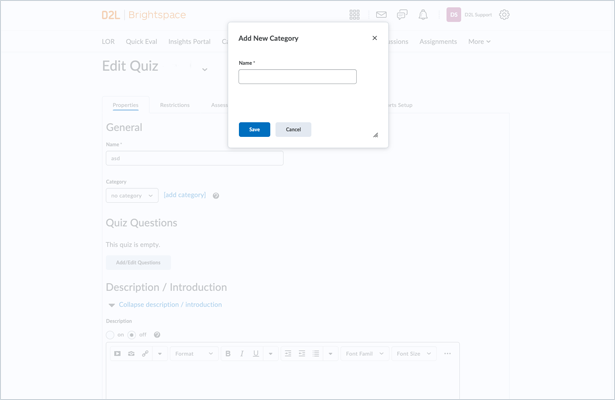
Figure: Example of a secondary window opening in a dialog.
| Impact of Change | Technical Details |
|---|---|
| Slight impact to all users. | Availability: This feature is available to all clients. To enable: This functionality is automatically enabled for Brightspace Learning Environment users. No further action is required. |
Brightspace Pulse – Comment on Activity Feed posts | New
To encourage class engagement, learners can now comment on Activity Feed posts in
Brightspace Pulse. Previously, learners could only read Activity Feed posts and comments
in Brightspace Pulse.
In Brightspace Pulse, tap the Courses tab, and then tap a course with Activity Feed enabled.
From the Activity Feed tab, tap the post you want to comment on, and then tap Add Comment. A browser opens, displaying the Activity Feed for the course in Brightspace Learning
Environment.
Tap the post you want to comment on, add your comment, and then tap Post. Your comment displays.
To close the browser and return to Brightspace Pulse, tap Done.
In Brightspace Pulse, refresh the page to display your comment.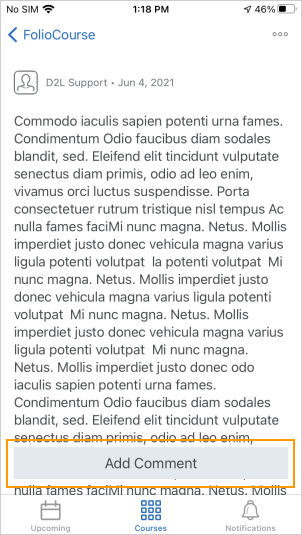
Figure: The new Add Comment button in Brightspace Pulse's Activity Feed
| Impact of Change | Technical Details |
|---|---|
|
No impact to administrators. |
Availability: This feature is available to Brightspace Pulse clients in all regions. |
| Slight impact to learners due to the ability to comment on Activity Feed posts in Brightspace Pulse. | This feature does not support pinning posts or configuring the Activity Feed. If Activity Feed is disabled in the course, the Activity Feed tab does not display. If comments are disabled in Activity Feed, the Add Comment button does not display. |
Brightspace Pulse – View all grades for a course | New
Learners can now view all grades for a course from a new Grades tab in the course. Previously, learners could only view course grades from notifications
in Brightspace Pulse or by opening a browser and navigating to the Grades tool in
Brightspace Learning Environment.
To view all grades for a course, tap the Courses tab. Next, tap a course, and then the Grades tab. All received grades for the course display, indicating if feedback is available. To
open the Grades tool in a browser and view full grade breakdowns and calculations,
tap View Grades in Browser.
To view feedback, tap a grade. The grade and text feedback display. To view details
about the associated activity in Brightspace Learning Environment, tap View Activity.
This implements Product Idea Exchange item D6422.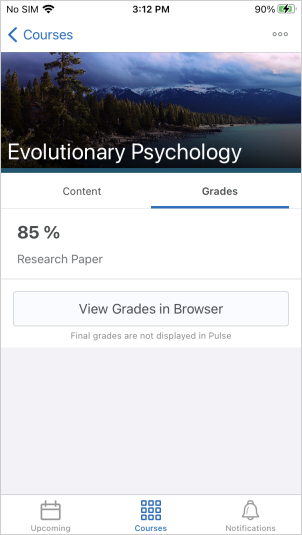
Figure: The new Grades tab for a course in Brightspace Pulse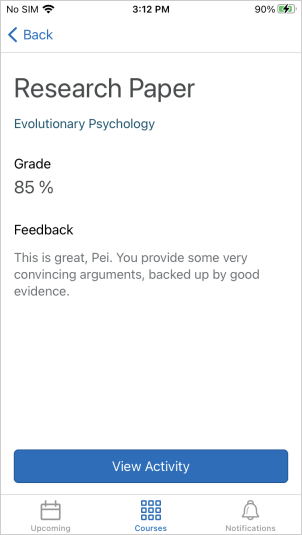
Figure: A graded activity with feedback in Brightspace Pulse
| Impact of Change | Technical Details |
|---|---|
|
No impact to administrators. |
Availability: This feature is available to Brightspace Pulse clients in all regions. |
| Slight impact to learners due to the ability to view all grades for a course in Brightspace Pulse. | This update does not include:
|
Brightspace Pulse – View content module descriptions | New
Learners can now view content module descriptions in Brightspace Pulse. Instructors
use module descriptions to communicate vital information to learners about specific
course content. Previously, module descriptions were only visible from Brightspace
Learning Environment, which may have caused learners to miss important information
when accessing courses from Brightspace Pulse.
This feature implements PIE items D4547 and D6460.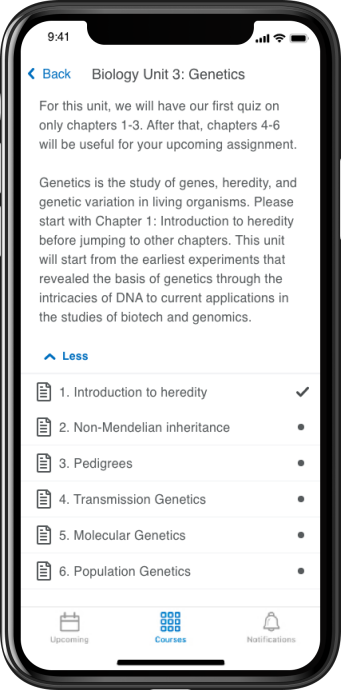
Figure: A content module description in Brightspace Pulse
| Impact of Change | Technical Details |
|---|---|
|
No impact to administrators. |
Availability: This feature is available to Brightspace Pulse clients in all regions. |
| Slight impact to instructors and learners due to the display of module descriptions in Brightspace Pulse. | A content module is a stand-alone instructional unit that is designed to satisfy one
or more learning objectives in a course. A module consists of one or more lessons. Learners cannot view or click links in module descriptions. Leaners cannot view images in module descriptions. Content module descriptions can be saved for offline viewing. |
Content - Date management and display | New
This feature allows instructors to manage dates for most topic types in the new content
experience (Lessons), and makes those dates visible to learners using the new learner
experience (LX). With this release, administrators can provide instructors with the
ability to opt-in to the new date management experience. This experience will be turned
on by default in a future release.
The following configuration variables control the availability of the new date management
experience:
- d2l.Tools.Content.LessonsCreateExperienceOptIn
- When set to Off: Lessons remains in its current state and there are no workflow or visible changes.
- When set to On(Opt-In): Instructors have the choice to opt in or out of the new experience.
- When set to On: The new experience is turned on with no choice to opt-out.
- d2l.Tools.Content.NewExperienceDisplayDates
- When set to Off: Dates are not displayed in Lessons and LX.
- When set to On: Dates are displayed in Lessons and LX.
When the new experience is turned on, the following changes are visible:
- The create and edit pages in Lessons allow instructors to select availability and
due dates for the following topic types:
- Modules (units, lessons, folders)
- HTML documents
- Course files & uploaded files
- Web links
- LTI links

Figure: Create and Edit Activity page in Lessons showing date pickers for Due Date
and Availability Dates
- All instructors and learners using Lessons can see availability and due dates on the navigation tiles in the left panel.
Note: dates that were set using Content Classic, Manage Dates, Course Builder, and Lessons
will all appear here.
Figure: Topic tile in Lessons displaying the due date and availability dates.
- All learners using LX can see availability and due dates in the table of contents, and on the navigation tiles in the left panel.
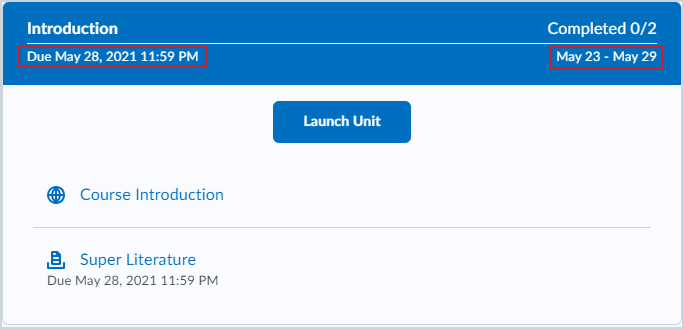
Figure: Table of contents in LX displaying the due date and availability dates.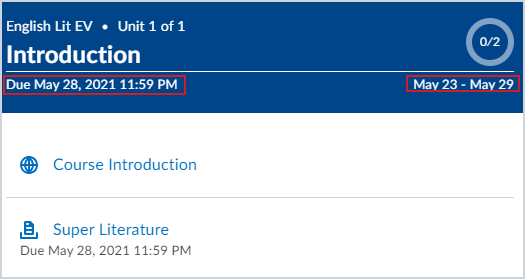
Figure: Topic tile in LX displaying the due date and availability dates.
- The visibility status of a topic or module is no longer controlled by its availability dates. Topics and modules are still hidden from learners outside of their availability window.
- Pacing dates are hidden to avoid conflicts.
- In the Create New menu, the External Tool Activity option is removed. Instructors must go through the Add Existing menu to begin the process of registering a new LTI link.
Date management for the following topic types will be made available in a future release:
- LOR links
- SCORM packages
- Google Drive links
- OneDrive links
| Impact of Change | Technical Details |
|---|---|
| Slight impact to administrators due to the ability to allow users to opt-in to the new date management experience. | Availability: This feature is available to all clients. To enable: Ensure the d2l.Tools.Content.LessonsCreateExperienceOptIn configuration variable is set to On or On(Opt-In) and the d2l.Tools.Content.NewExperienceDisplayDates configuration variable is set to On. |
| Moderate impact to instructors due to a new date management experience in Lessons. | N/A |
Data Hub - Accommodations Brightspace Data Set | New
To increase the value of the Data Hub offering, this release adds a new Brightspace
Data Set for the Accommodations tool. The Accommodations Profile Log data set returns all accommodations created for learners in an org unit.
Clients only see the new data set if the Accommodations tool is On at the Org level.
| Impact of Change | Technical Details |
|---|---|
| Slight impact to administrators due to the addition of new Brightspace Data Sets. | Availability: This feature is available to Brightspace Insights and Brightspace Core clients in
all regions. To enable: Ensure the Can Access Brightspace Data Sets permission is granted to administrators at the org level. New data sets appear the first time the data set runs after the CD update. |
Discussions - Consistent evaluation experience | New
This feature updates the user evaluation experience when assessing a topic or an individual
learner, allowing instructors to better review and evaluate discussion contributions. The
evaluation interface for Discussions has a similar layout as the Assignments - Consistent evaluation experience.
The d2l.Tools.Activities.CEDiscussionOptIn configuration variable allows administrators to provide an opt-in ability so users
can try out the consistent evaluation experience with this tool. The default value
for this configuration variable is Off. Setting the value to On(Opt-In) enables all users to opt-in to the experience on an individual basis. Setting the
value to On turns on the new experience for all users and removes the ability to use the previous
evaluation experience.
This new experience involves a new page layout, with evaluation tools and the post
being evaluated displaying side-by-side. Assessment workflows have not changed.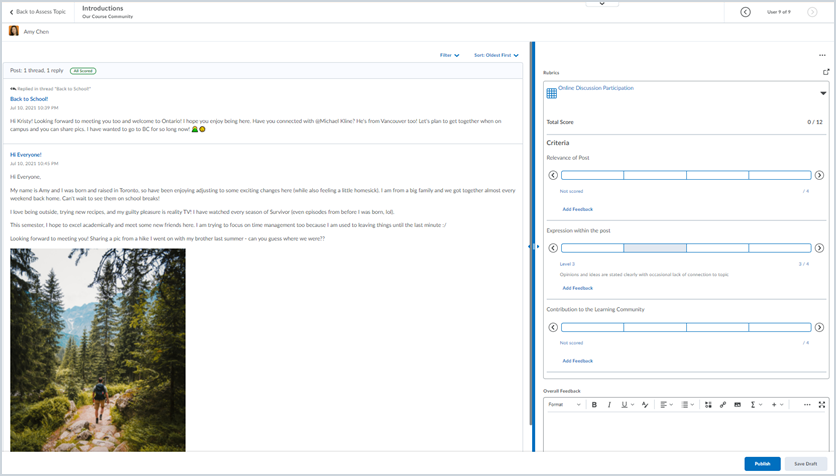
Figure: New evaluation experience for Discussions, with posts and evaluation tools
displayed side-by-side.
For more detail about the improvements in this new experience, visit the Welcome to Our New Discussion Evaluation Experience post on Brightspace Community.
For additional information on the consistent evaluation experience across all Brightspace
tools, visit the What is Coming in Evaluation: 20.20.12 post on Brightspace Community.
This feature implements PIE items D2211, D2348, D2514, D3430, D3673, D4859, D4920,
D5148, D4393, D6911, and D7253.
| Impact of Change | Technical Details |
|---|---|
| Slight impact to administrators due to the ability to allow users to opt-in to the new evaluation experience in Discussions, or permanently enable the new experience. | Availability: This feature is available to all clients. To enable: Ensure the d2l.Tools.Activities.CEDiscussionOptIn configuration variable is set to On(Opt-In) or On. |
| Moderate impact to instructors due to a new evaluation experience available in Discussions. Depending on the settings of the new configuration variable, instructors have the option to opt-in to the new experience. | N/A |
Discussions – Improvements to visibility and posting restrictions | New
For the August 2021/20.21.8 release, administrators can choose to opt-in to a new
workflow that makes it easier for instructors to set visibility and posting restrictions
for discussion forums and topics. More specifically, this change simplifies date management
for discussion activities, offering a more consistent, simplified, and consolidated
experience for instructors. For the September 2021/20.21.9 release, this workflow
will be on by default. For the December 2021/20.21.12 release, this workflow will
be the only workflow for setting visibility and posting restrictions. For more information
on these changes, see the Changes To Availability And Locking Dates For A Consolidated Dates Workflow blog post.
To allow instructors to try the new workflow, administrators set the new d2l.Tools.Discuss.ConsolidatedDatesEnabled configuration variable to ON. Once set, all existing settings for visibility and posting restrictions are migrated
to the new locations in the Discussions tool. Instructors do not need to make any
changes to their new or existing courses.
Once the new workflow is enabled, the following changes are visible to instructors
when creating or editing discussion forums and topics:
Note: These changes also affect the Classic Content and Manage Dates tools.
- From the Restrictions tab, the previous Locking Options are now consolidated with the Availability Start Date and End Date options and display as the following new options:
- Visible with access restricted before/after start/end. The topic/forum is visible to learners before/after the start/end date, but they cannot access it. Previously, Classic Content was the only tool to make discussions visible without access.
- Visible with submission restricted before/after start/end. The topic/forum is visible to learners before/after the start/end date and they can access it, but they cannot post new threads or replies. This effectively makes a discussion read-only. Previously, this was accomplished with the lock option or unlock dates.
- Hidden before/after start/end. The topic/forum is hidden from learners until the start/end date. This is a new feature. Calendar events for Availability Starts and Availability Ends are hidden until the start/end date. Notifications are also not sent until the start/end date. Previously, the hidden status of a discussion topic was decided by the tool displaying the topic.
- From the Restrictions tab, the Display in Calendar option is now consolidated with the Availability Start Date and End Date options, which adds the start date and end dates to the calendar. Previously, the tool decided which calendar event should be added to the calendar. With this change, calendar events for availability dates may change and additional events for Availability Start Dates may be added.
- Calendar events for unlocked dates are now hidden from learners.
- Where Discussions and User Progress may have previously hidden a topic or forum when outside of availability dates, those tools now may show them as visible, but inaccessible.
- From Discussion Settings, instructors can now set the default visibility and access behavior for new discussion forums and topics. The defaults can be set at an organization level.
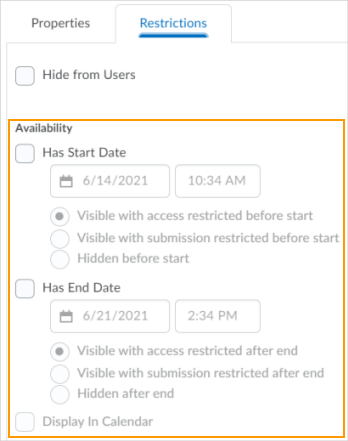
Figure: The new consolidated options for visibility and posting restrictions in the
Restrictions tab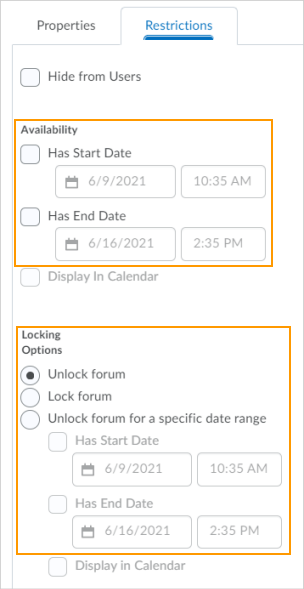
Figure: The previous options for visibility and posting restrictions in the Restrictions
tab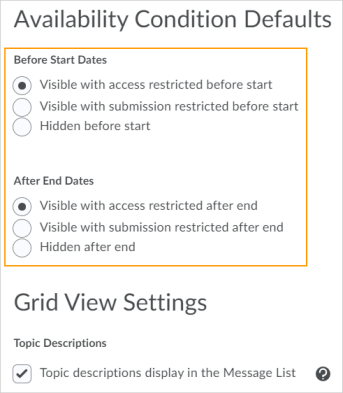
Figure: The new default options for visibility and posting restrictions in the Discussions
Settings
| Impact of Change | Technical Details |
|---|---|
|
No impact to administrators. |
Availability: This feature is available to Brightspace Core clients in all regions. |
| Moderate impact to instructors due to a new workflow for setting visibility and posting restrictions for discussion forums and topics. | Availability specifies when learners can access (or view) a forum or topic based on
a specific date set by an instructor. For example, an instructor sets a date to make
a discussion forum available to learners after the end date for finishing a course
module. Posting restrictions (also known as locking and unlocking) specify if learners can post or reply to a forum or topic based on a specific date set by an instructor. For example, an instructor sets a date to lock a discussion topic after making it available, giving learners time to read and understand the discussion topic, but not post replies. The instructor also sets a date to unlock the topic several days later, allowing learners to post their well thought out replies. |
Grades (Mastery View) – Evaluated and Aligned Activity Counter | Removed
To improve page performance for the Grade book Mastery View, the Evaluated and Aligned
Activity counter has been removed. We recognize that this is important contextual
information for instructors and evaluators when reviewing the overall level of achievement
for a learner. D2L is re-evaluating ways in which to present this information while
not impacting the performance of this page.
The information from the Evaluated and Aligned Activity data element will be reintroduced
in a future release with additional context to help clients better analyze what the
numbers represent in their learning environment.
| Impact of Change | Technical Details |
|---|---|
| Slight impact to instructors who no longer have the Evaluated and Aligned Activity data element in the Grade book Mastery view. | N/A |
Local Authentication Security – User interface improvements | Updated
This feature builds on the Local Authentication Security – Improvements | Updated feature that was released in July 2021/20.21.07.
The Local Authentication Security page now includes updated text and user interface
options to increase clarity around the functionality on this page. The Local Authentication Allow List field is renamed to read as Local Authentication Authorized Users and appears as a drop-down menu with the following options:
- Not Enabled
- Restrict Local Login only for Authorized Users
- Enable 2FA for Authorized Users
- Restrict Local Login and enable 2FA for Authorized Users
Note: When you select any option that restricts local logins and then click Save, a confirmation message appears.
The User List is now renamed and reads as Authorized Users.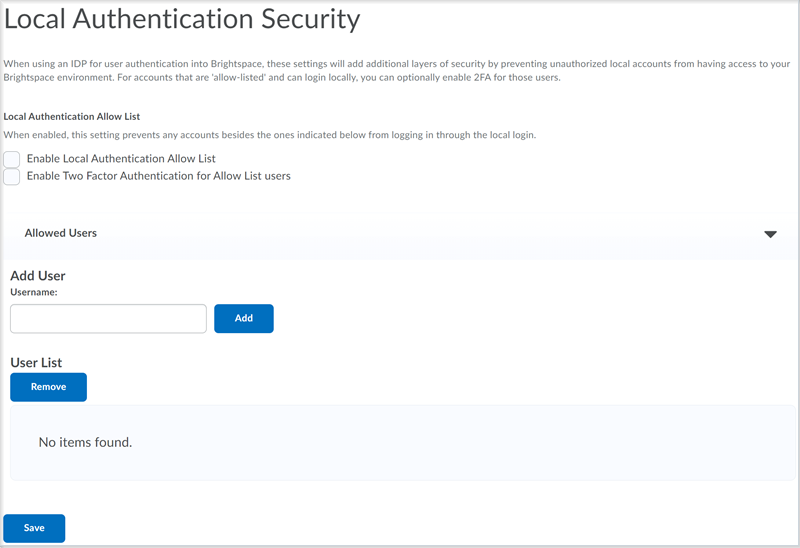
Figure: The Local Authentication Security page before the update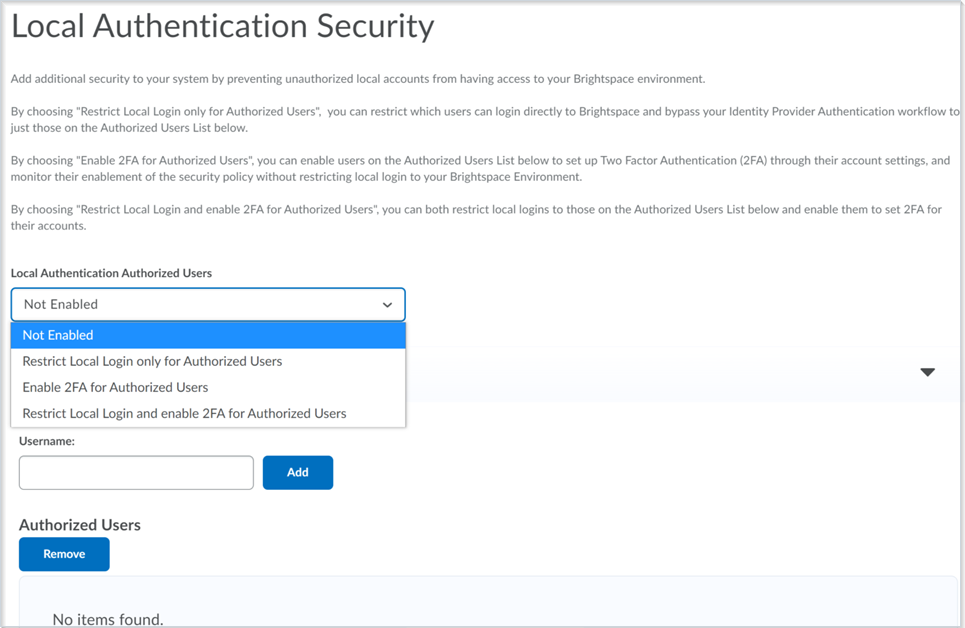
Figure: The updated Local Authentication Security page
This change means that users on the Authorized Users list can have 2FA enabled for their accounts with or without enabling the restriction
of local logins only to the accounts on the list.
| Impact of Change | Technical Details |
|---|---|
| Slight impact to administrators due to the above improvements. | Availability: This feature is available to all clients To enable: The Local Authentication Security page is set to ON by default on the Organization Tools page for all clients. |
Rubrics – Increased accessibility with labels on radio buttons | Updated
To provide a better experience to clients using screen readers, criterion levels now
indicate the level name and point value of each radio button when it has the focus.
Previously, screen readers only indicated “radio button X out of Y” or “radio button,
not selected” depending on whether the focus is on a selected criterion.
In addition, the mobile view of Rubrics now has radio buttons implemented to describe
the level name and point value of each criterion level, consistent with the view on
a larger screen.
Note: Depending on the screen reader you use, the way of listing all the radio buttons on
a page differs. For example, In NVDA, press INSERT+F7; in JAWS, press CTRL+INSERT+A. In general, D2L tests compatibility with the following screen readers: NVDA, JAWS,
and Voiceover.
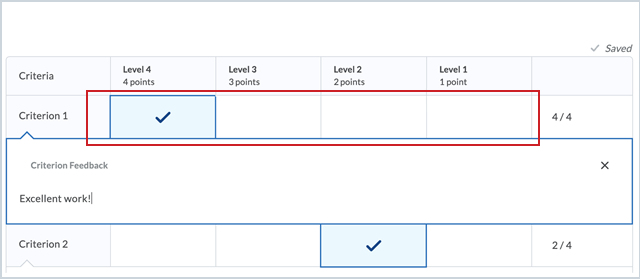
Figure: Criterion level rows behave as radio buttons for screen readers.
| Impact of Change | Technical Details |
|---|---|
| Slight impact to instructors due to improved accessibility on rubric labels. | Availability: This feature is available to all clients using assistive technology with the updated
Rubrics experience. To enable: This functionality is automatically available to updated Rubrics experience users. |
Rubrics – Inline grading improvements | Updated
There have been improvements to the ease of use of the inline grading experience, including changes to ensure grading experience parity for screen reader users. Previously, screen reader users were unable to grade or review tasks due to missing information. In addition, the updates now include the following:
- The interaction of the arrow buttons at either end of the evaluation slider now indicate a hover state compared to a focus state. If there is no level under the hover pointer, the level area is empty.
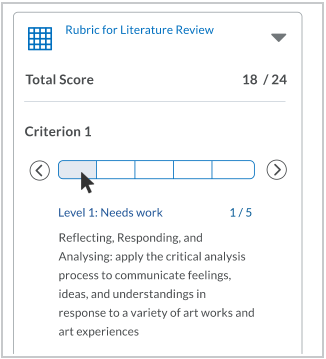
Figure: If the hover pointer is on a level, the name, description, and score appear
in the level information area below the slider.
- Keyboard navigation of the slider evaluation levels identify the focus and indicate the criterion you are viewing. When the keyboard focus is on a level, you can press the arrow keys at the beginning and end of the slider or use the left and right arrow keys on the keyboard to move the focus within a scale. In grading mode, moving the focus to a level directly selects the level. You can also press Enter to select or unselect a level. In preview mode, the selected level does not change when you review other levels’ information.
![]()
Figure: The focused level is highlighted inside the slider segment.
- Keyboard navigation of the slider evaluation levels more clearly identify the focus and level you have selected in grading mode. You can use the right or left arrow key at the beginning and end of the slider to move the focus within a scale. Press Enter or use the left and right arrow keys on the keyboard to select and deselect the level.
![]()
Figure: When the level is selected, a larger box outlines the slider level, and a
checkmark appears in the level
- The level name and description of an evaluation level appear below the evaluation slider in the selected state, and the selection indicator appears on the slider at the chosen level.

Figure: When a level is selected, the level name and description appear, along with
the selection indicator
- When the rubric has been graded, the level information area displays the selected level’s information by default, unless other levels are in hover state in grading mode, or in hover or focus state in reviewing mode.
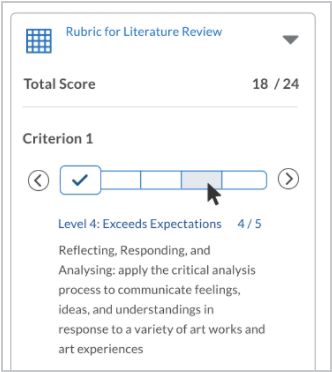
Figure: When a non-selected level is in hover state, the name, description, and score
appear in the level information area below the slider.
- When you move the selection block to a different level, there is now an animation to smoothly transition to the new level.
This feature implements PIE item D7666.
| Impact of Change | Technical Details |
|---|---|
| Slight impact to instructors who use the inline grading experience. | Availability: This feature is available to all clients. To enable: This functionality is automatically enabled for Rubrics users. |
Rubrics - Overall Score now appears in Mobile View and the New Assignment and Discussion Evaluation Experiences | Updated
When an instructor using the New Assignment Evaluation Experience opens a rubric in
a new window, the Overall Score displays for each rubric, and the instructor can override
the level if necessary. Previously, if an instructor did not open a new window, rather,
they viewed the rubrics inline in the New Assignment Evaluation Experience tool, the Overall Score did not appear, and the instructor could not override the level. As a result, text-only
rubrics could not be assessed because the Overall Score was not available.
Now, instructors using Mobile view can evaluate text-only rubrics for assignments
(using the New Assignment Evaluation Experience) and can evaluate text-only rubrics
for discussions (using the New Discussions Assignments Evaluation Experience) as expected. 
Figure: The Overall Score in Mobile and New Assignment Evaluation Experience views
This feature implements PIE item D7666.
| Impact of Change | Technical Details |
|---|---|
| Slight impact to instructors due to the availability of the Overall Score in the New Assignment Evaluation Experience and Mobile View for text-only rubrics | Availability: This feature is available to all clients using the New Rubrics Evaluation experience
who are also using the New Assignment Evaluation Experience or Mobile View to evaluate
Assignments and Discussions. To enable: This functionality is automatically enabled for all New Rubrics Evaluation experience users. |
